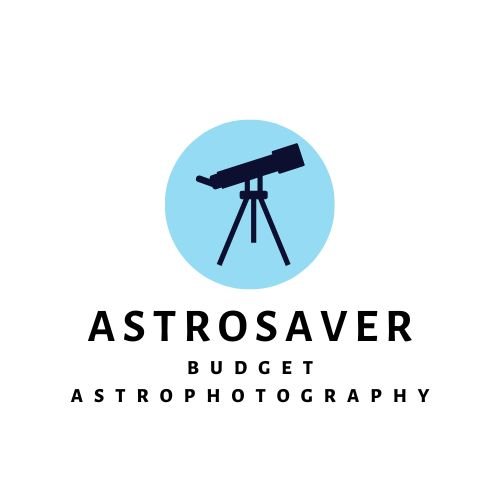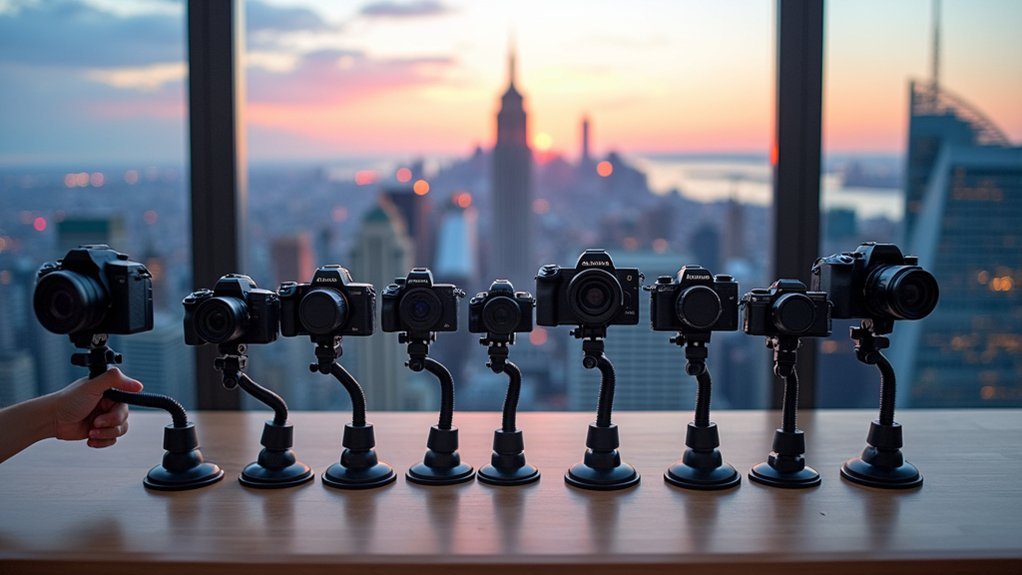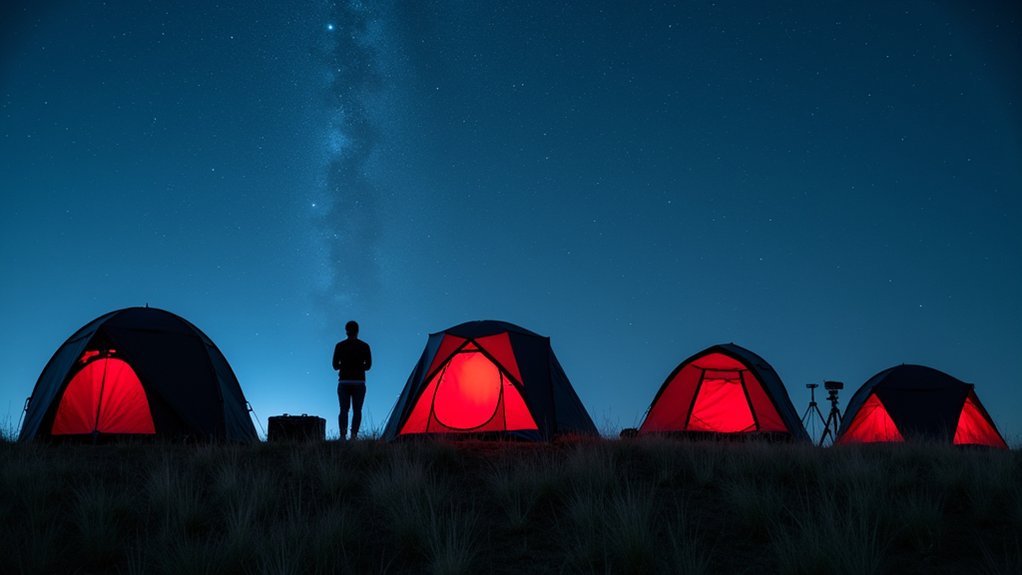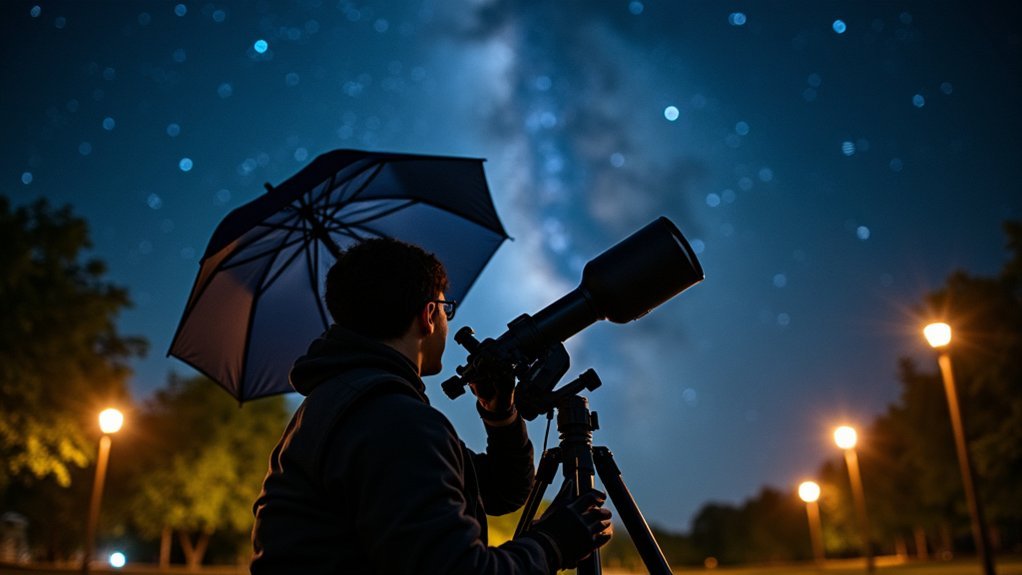For successful dark frame calibration, you’ll need light-tight dust caps to guarantee complete darkness, remote shutter releases to prevent vibrations, and temperature control systems to manage thermal noise. Use stable power supplies and capture in a completely dark environment. Track your settings with reference cards and process your frames with specialized software like DeepSkyStacker or PixInsight. Consistent temperature between dark and light frames is essential for effective noise reduction. Immerse yourself in our complete guide for professional-level calibration techniques.
Light-Tight Camera Covers and Dust Caps

When capturing dark frames for astrophotography calibration, light-tight camera covers and dust caps serve as your first line of defense against unwanted light contamination.
Using caps specifically designed for your telescope or camera model guarantees complete darkness during exposure, which is critical for effective noise reduction.
Before beginning your dark frame session, check for gaps or potential light leaks around your dust cap. Even minimal light leakage can introduce unwanted artifacts, compromising your calibration data.
For best results, select covers made from non-reflective materials to prevent internal reflections that might interfere with your dark frames.
Remote Shutter Release Controllers and Intervalometers
Although many astrophotographers focus primarily on their optical equipment, remote shutter release controllers and intervalometers are essential tools for capturing pristine dark frames. When you’re collecting calibration data, these devices eliminate the need to touch your camera, preserving the integrity of your images.
- Your remote shutter release prevents vibrations that can compromise dark frame quality.
- Intervalometers automate the capture of multiple dark frames with consistent settings.
- Programmed delays between shots guarantee proper sensor cooling for accurate calibration.
- Advanced controllers offer customizable settings for both dark and light frame capture.
- These tools enhance your workflow by collecting numerous dark frames without constant supervision.
Camera Temperature Control Systems

Camera cooling units greatly reduce thermal noise by maintaining your sensor at consistent temperatures below ambient conditions during long exposures.
You’ll find that temperature stability directly impacts the effectiveness of dark frame calibration, as even slight thermal variations can introduce calibration inconsistencies.
Proper ambient heat management through dedicated cooling systems allows you to capture cleaner images with less unwanted noise, especially during warm-weather astrophotography sessions.
Cooling Units And Technologies
Since sensor temperature directly impacts dark current noise, effective cooling systems represent perhaps the most critical component in dark frame calibration equipment. Your cooled astronomy camera needs robust temperature management to deliver ideal results.
- Thermoelectric coolers (TECs) can reduce sensor temperature by 30°C+ below ambient, dramatically minimizing dark current.
- User-adjustable temperature controls let you customize cooling based on your environmental conditions and exposure length.
- Dual-stage TEC systems offer superior cooling efficiency and temperature stability across multiple imaging sessions.
- Consistent cooling guarantees your dark frames remain valid references even when captured on different nights.
- Proper thermal management not only improves calibration quality but extends your camera sensor’s lifespan by reducing thermal stress.
Investing in quality cooling technology pays dividends through cleaner images and more reliable calibration frames.
Temperature Stability Importance
Maintaining consistent sensor temperature throughout your imaging session represents the cornerstone of effective dark frame calibration.
When your camera’s sensor temperature fluctuates, the dark current—a primary source of thermal noise—changes with it, rendering your carefully captured dark frames less effective for noise reduction.
Temperature stability guarantees that dark frames accurately match the noise profile present in your light frames.
Without it, you’ll struggle to remove noise patterns consistently, compromising final image quality.
This is why cooled cameras have become essential tools for serious astrophotographers; their built-in temperature control systems maintain the sensor at a precise, stable temperature regardless of ambient conditions.
Remember that even small temperature variations can introduce subtle inconsistencies, so investing in reliable temperature control equipment will considerably improve your calibration results and overall image quality.
Ambient Heat Management
While dark frames help reduce noise in your astrophotography, effectively managing ambient heat around your camera system dramatically improves their efficacy. Controlling your camera’s temperature is vital for consistent dark frame calibration and overall image quality.
- Install thermoelectric coolers (TECs) to maintain your DSLR or mirrorless camera at an ideal -10°C to -20°C range.
- Monitor your camera’s temperature throughout your imaging session to guarantee dark frames match light frames.
- Create a shield around your setup to minimize ambient temperature fluctuations from winds or nearby heat sources.
- Consider specialized cooling systems that provide temperature stability within ±1°C for precise calibration.
- Remember that reducing thermal noise through cooling allows for longer exposures while preserving image detail.
Power Supply Stability Solutions

Power supply stability demands your attention with three critical solutions for effective dark frame calibration.
You’ll need robust voltage regulation systems to shield your imaging equipment from harmful fluctuations, along with careful battery capacity planning to guarantee uninterrupted operation during extended sessions.
Electrical noise filtering techniques, such as power conditioners and dedicated astronomical power supplies, will eliminate interference that can compromise your calibration frames’ quality.
Voltage Regulation Systems
Three essential components of any serious astrophotography setup are voltage regulation systems that guarantee your camera receives clean, consistent power throughout long exposure sessions.
These systems help reduce the noise in your images and maintain calibration accuracy during dark frame capture.
- Dedicated power supplies with built-in regulation keep your equipment operating within ideal voltage ranges
- Power conditioners filter out electrical noise that could interfere with sensitive imaging equipment
- Stable power prevents voltage drops or spikes that degrade image quality
- Consistent voltage guarantees thermal noise remains uniform across dark frames
- Battery packs with regulation circuitry provide field solutions when wall power isn’t available
You’ll notice immediate improvements in your dark frame calibration when voltage fluctuations are eliminated, resulting in cleaner final images with better signal-to-noise ratios.
Battery Capacity Planning
Beyond voltage regulation, effective battery capacity planning forms the backbone of any reliable astrophotography power system.
You’ll need sufficient battery capacity to prevent interruptions during critical dark frame collection, which can compromise your entire dataset.
Invest in high-capacity lithium-ion batteries rather than standard alkalines to maximize your shooting time and performance reliability.
For extended sessions with longer exposure requirements, supplement with a portable power bank or AC adapter solution to guarantee continuous operation.
Make monitoring battery levels a priority by using an external battery monitor – this proactive approach prevents unexpected power loss during capture sequences.
Remember that temperature fluctuations during night shoots can greatly impact battery performance, so choose options with temperature management features for consistent operation in varying conditions.
Noise Filtering Techniques
While capturing the perfect dark frame, electrical interference can silently compromise your data quality without any visual warning.
Power supply stability directly impacts your calibration results—clean power means cleaner frames.
- Use a regulated power supply dedicated to your imaging equipment to maintain consistent voltage during long exposures.
- Install power conditioning devices like line conditioners or UPS to filter electrical noise before it reaches your camera.
- Keep all equipment properly grounded and use shielded cables to minimize electromagnetic interference.
- Check connections and cables regularly to prevent intermittent power issues that introduce random noise.
- Consider isolation transformers for extreme noise filtering in environments with poor power quality.
Dark Room Setup Essentials

Creating an effective dark room environment stands as the foundation of successful dark frame calibration. You’ll need to guarantee complete darkness by covering all windows with light-blocking materials. Place your dust cap securely on your telescope or camera lens to prevent any light from reaching the sensor during capture.
Set up your equipment in a temperature-controlled space to stabilize thermal noise patterns. An intervalometer will automate your dark frame sequence, maintaining consistent exposure settings while reducing handling errors.
| Element | Purpose | Emotion |
|---|---|---|
| Blackout curtains | Light elimination | Confidence |
| Dust cap | Sensor protection | Security |
| Intervalometer | Automation | Relief |
Remember to choose a quiet location for your dark room setup to avoid vibrations that could compromise your calibration results.
Insulated Imaging Boxes and Shields
You’ll want an insulated imaging box with proper ventilation slots to maintain stable sensor temperatures while protecting your camera from external thermal fluctuations during dark frame captures.
Consider incorporating light-blocking shields made of opaque materials that completely seal against any ambient light leakage, which can contaminate your calibration frames.
Pairing these physical protections with a reliable temperature monitoring system allows you to track conditions inside your setup and guarantee consistent sensor performance throughout your imaging session.
Insulated Box Design Considerations
When capturing dark frames for accurate calibration, an insulated imaging box becomes essential for maintaining thermal stability and ensuring light-tight conditions. Your insulated box should minimize temperature fluctuations while providing complete darkness for your camera sensor.
- Construct your box using opaque materials with light-tight seals to prevent any stray light from contaminating your dark frames.
- Include insulation materials like foam or reflective barriers to achieve thermal stability by blocking external temperature variations.
- Design with convenient access points so you can adjust camera settings without disrupting the controlled environment.
- Consider incorporating a small fan or passive ventilation system to prevent heat buildup during extended imaging sessions.
- Size your box appropriately to accommodate your camera body, any attached accessories, and proper airflow around the equipment.
Light-Blocking Shield Solutions
Building on proper insulation design, effective light-blocking shields represent the cornerstone of successful dark frame capture. These insulated imaging boxes create the completely dark environment necessary for accurate calibration frames, eliminating stray light that would otherwise contaminate your results.
The primary advantage of a quality light-blocking shield extends beyond darkness—it also stabilizes temperature, considerably reducing thermal noise during exposure. This consistency is essential for matching your dark frames to light frames captured under varying conditions.
You don’t need expensive equipment to achieve professional results. Constructing an affordable solution from black foam board or cardboard works remarkably well, especially in light-polluted urban environments.
Your homemade shield can be customized to accommodate different camera setups while ensuring settings remain unchanged throughout the capture process.
Temperature Monitoring Equipment
Although light-blocking is vital, precise temperature monitoring equipment forms the backbone of reliable dark frame calibration. Your dark frames will only be effective when captured at the same sensor temperature as your light frames.
- Insulated imaging boxes create a stable thermal environment for your camera, maintaining consistent temperatures throughout your imaging session.
- Temperature sensors or thermometers allow you to track sensor temperature fluctuations in real-time.
- Insulated shields made from foam or mylar help reflect heat and prevent temperature spikes that could invalidate your calibration.
- For non-cooled cameras, temperature monitoring equipment is particularly important as thermal noise increases considerably with temperature variations.
- Combining proper insulation with active monitoring guarantees your dark frames accurately match the thermal conditions of your light frames, resulting in cleaner final images.
Tracking Systems for Consistent Field Alignment
The backbone of successful dark frame calibration lies in your ability to maintain consistent field alignment throughout the imaging session.
Investing in quality tracking systems prevents unwanted star trails during long exposures and guarantees your calibration frames match your light frames perfectly.
Look for mounts with dual-axis tracking capabilities that compensate for Earth’s rotation in both right ascension and declination. An accurate polar alignment is non-negotiable—it minimizes drift and dramatically improves your dark frame calibration results.
Consider systems with autoguiding features that use guide scopes and cameras to make automatic corrections for minor misalignments.
The best tracking mounts can support various equipment payloads, giving you flexibility to use different telescopes and cameras while maintaining the stability essential for precise calibration work.
Data Storage and Transfer Equipment

Successful dark frame calibration requires three essential data management components working seamlessly together. Your astrophotography workflow demands reliable storage solutions, fast transfer capabilities, and organized file systems to handle the substantial data volume generated during imaging sessions.
Data management excellence forms the backbone of effective astrophotography calibration, ensuring seamless workflow from capture to processing.
- Invest in a high-capacity external hard drive specifically dedicated to storing your raw light frames and calibration data.
- Utilize high-speed USB 3.0 or Thunderbolt connections to minimize transfer times between your camera and storage devices.
- Select memory cards with substantial capacity (128GB+) and fast write speeds to prevent interruptions during long exposure sessions.
- Implement cloud storage solutions as a secondary backup to protect against physical damage or hardware failure.
- Develop an organized file management system that allows quick retrieval of dark frames and other calibration files when needed for processing.
Time Management Tools for Exposure Synchronization
Precisely timing your dark frame captures represents a fundamental aspect of calibration that elevates your astrophotography beyond basic data management. An intervalometer automates your capture sequences, guaranteeing dark frames match your light frames perfectly.
| Tool | Benefit for Dark Frame Calibration |
|---|---|
| Intervalometer | Automates capture sequence timing |
| Remote Shutter Release | Minimizes camera shake during exposures |
| Astro Photography Tool | Schedules automated dark frame captures |
| Temperature Monitor | Guarantees consistent conditions for matching frames |
| Timing Log | Tracks exposure settings for proper synchronization |
Weather Monitoring Instruments
Because environmental conditions directly impact sensor temperature and noise patterns, incorporating weather monitoring tools into your dark frame workflow greatly improves calibration accuracy.
Your calibration frames’ quality depends heavily on matching the exact conditions of your light frames.
- Use a precise thermometer to track your camera sensor’s temperature—dark frames must match light frames for effective noise reduction.
- Monitor humidity levels with a hygrometer to protect equipment and maintain consistent performance during long imaging sessions.
- Employ a barometer to track atmospheric pressure changes that might affect your optical system.
- Install an anemometer to assess wind conditions that could introduce vibrations during exposure.
- Utilize a light pollution meter to determine ideal times for capturing clean dark frames with minimal ambient light contamination.
Weather monitoring instruments aren’t just accessories—they’re essential components that help you produce consistently superior calibration data.
Camera Settings Reference Cards
Memory cards can fail and notebooks get lost, but dedicated camera settings reference cards provide a reliable system for documenting your dark frame parameters.
These waterproof cards let you record vital details like exposure time, ISO, and temperature—ensuring you’ll match your dark frames perfectly to your light frames for ideal calibration.
Recording exposure time, ISO and temperature ensures perfect calibration between your dark frames and light frames.
Create custom cards that include checkboxes for RAW format and Manual/Bulb mode selection, as these settings are essential for high-quality dark frames.
Include a reminder about using your dust cap and camera capture software for consistent results.
You’ll also want to note your target count (between 20-50 frames) to produce an effective master dark frame.
Keep these cards in your equipment case for quick reference during nighttime sessions when memory often falters.
Calibration Software and Processing Tools
While reference cards help you track your settings in the field, effective dark frame calibration ultimately depends on specialized software to process your captured data.
Popular calibration software like DeepSkyStacker and PixInsight provides essential tools for transforming your raw dark frames into master calibration files that greatly reduce noise in your final images.
- DeepSkyStacker recommends at least 20 dark frames for basic noise reduction, but 50-100 frames creates nearly noise-free masters
- PixInsight offers advanced noise profile analysis and parameter-specific calibration features
- Automating capture with intervalometers or capture software guarantees consistent dark frame exposure settings
- Stacking software combines multiple frames to effectively subtract noise patterns from light frames
- Combining dithering techniques through PHD2 or Astro Photography Tool with dark frame calibration further enhances image quality
Battery Life Extension Accessories
Every successful dark frame calibration session depends on reliable, long-lasting power. When you’re capturing dark frames under night skies, external battery packs become essential tools, preventing interruptions during vital imaging sequences.
Invest in high-capacity lithium-ion batteries that can withstand frequent cycling and provide extended runtimes for your astrophotography sessions. These batteries form the backbone of your power management strategy.
Maximize battery life by utilizing power-saving settings on your camera—disable live view and unnecessary features during dark frame captures. For extended field sessions, consider solar-powered chargers that offer eco-friendly recharging options without returning to base.
Always bring spare batteries and implement a management system to track battery health. With proper power planning, you’ll never miss capturing those vital calibration frames.
Frequently Asked Questions
How Many Dark Calibration Frames Should I Take?
You should take 20-50 dark calibration frames for effective noise reduction. If you’re using a non-cooled camera or have a messier sensor, consider capturing up to 100 frames for nearly noise-free results.
What Are the Most Important Calibration Frames?
The most important calibration frames are Dark Frames, Flat Frames, and Bias Frames. You’ll need all three to effectively reduce thermal noise, correct vignetting and dust spots, and establish a proper noise floor.
Is 10 Dark Frames Enough?
Ten dark frames will help, but you’ll get better noise reduction with at least 20. For truly effective calibration, aim for 50 frames, especially if you’re using a non-cooled camera with variable thermal noise.
What Is Dark Calibration?
Dark calibration is when you capture images with your lens cap on to record sensor noise patterns. You’ll later subtract these “dark frames” from your actual astrophotography images to reduce fixed-pattern noise and improve image quality.
In Summary
You’ve now got all the essential equipment needed for perfect dark frame calibration. Remember, it’s not just about having the right gear but using it correctly. Keep your temperature stable, power consistent, and workflow organized. Don’t overlook small details like proper covers and battery management. With these tools at your disposal, you’ll greatly improve your astrophotography’s quality and spend less time post-processing.





Leave a Reply